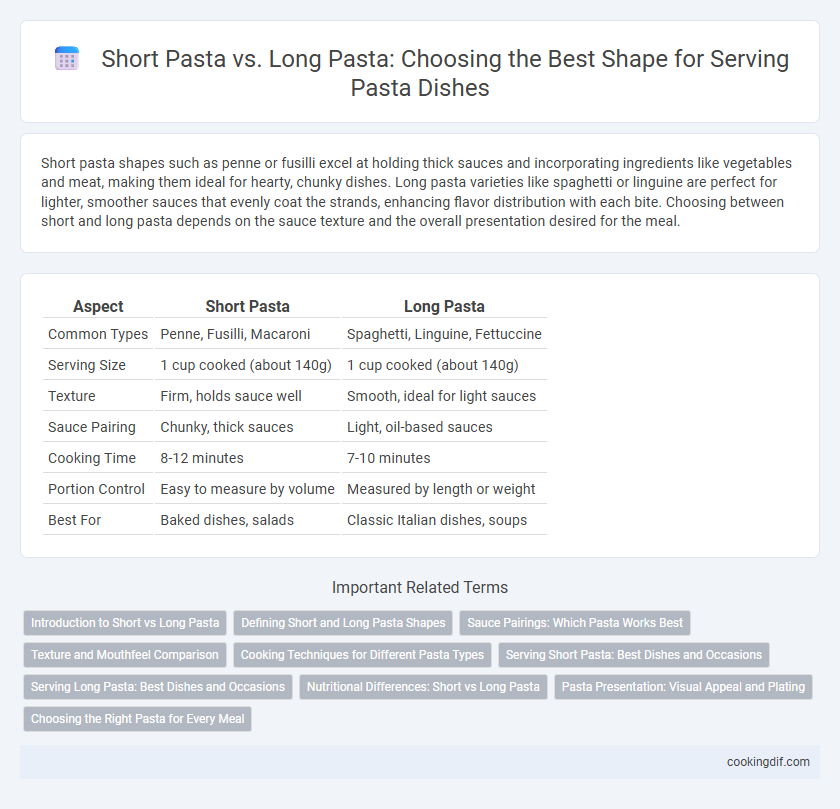Short pasta shapes such as penne or fusilli excel at holding thick sauces and incorporating ingredients like vegetables and meat, making them ideal for hearty, chunky dishes. Long pasta varieties like spaghetti or linguine are perfect for lighter, smoother sauces that evenly coat the strands, enhancing flavor distribution with each bite. Choosing between short and long pasta depends on the sauce texture and the overall presentation desired for the meal.
Table of Comparison
| Aspect | Short Pasta | Long Pasta |
|---|---|---|
| Common Types | Penne, Fusilli, Macaroni | Spaghetti, Linguine, Fettuccine |
| Serving Size | 1 cup cooked (about 140g) | 1 cup cooked (about 140g) |
| Texture | Firm, holds sauce well | Smooth, ideal for light sauces |
| Sauce Pairing | Chunky, thick sauces | Light, oil-based sauces |
| Cooking Time | 8-12 minutes | 7-10 minutes |
| Portion Control | Easy to measure by volume | Measured by length or weight |
| Best For | Baked dishes, salads | Classic Italian dishes, soups |
Introduction to Short vs Long Pasta
Short pasta varieties like penne, rigatoni, and fusilli are ideal for capturing thick sauces and mixing well in baked dishes, providing a hearty and textured bite. Long pasta types such as spaghetti, fettuccine, and linguine excel at showcasing delicate olive oil or tomato-based sauces, offering a smooth, elegant presentation. Choosing between short and long pasta depends on sauce consistency, dish style, and desired eating experience.
Defining Short and Long Pasta Shapes
Short pasta shapes, such as penne, rigatoni, and farfalle, are typically under two inches long and are ideal for hearty sauces, baked dishes, and salads due to their ability to hold sauce within their ridges and hollow centers. Long pasta varieties like spaghetti, linguine, and fettuccine range from 8 to 12 inches and excel at twirling, making them perfect for lighter, smoother sauces that cling to their strands. Understanding these distinct characteristics helps determine the best pairing for sauces and presentation, enhancing the overall dining experience.
Sauce Pairings: Which Pasta Works Best
Short pasta varieties such as penne, rigatoni, and rotini hold chunky and hearty sauces like Bolognese or pesto exceptionally well, allowing flavors to cling to their ridges and hollow shapes. Long pasta types like spaghetti, linguine, and fettuccine are ideal for lighter, smoother sauces including marinara, Alfredo, or garlic and olive oil, as their slender form provides even sauce coating and ease of twirling. Choosing pasta based on sauce texture enhances the overall dining experience by maximizing flavor absorption and mouthfeel.
Texture and Mouthfeel Comparison
Short pasta varieties like penne and rigatoni provide a dense, chewy texture that holds sauces well, enhancing every bite with a robust mouthfeel. Long pasta such as spaghetti and fettuccine delivers a smoother, silkier experience with a tender yet slightly firm consistency that allows for a more delicate coating of sauce. Texture and mouthfeel preferences often depend on the sauce type and desired eating experience, with short pasta offering more bite and long pasta emphasizing smoothness.
Cooking Techniques for Different Pasta Types
Short pasta such as penne and rigatoni cook more evenly in boiling water due to their compact shape, allowing sauce to cling inside grooves and tubes, enhancing flavor absorption. Long pasta varieties like spaghetti and fettuccine require careful stirring to prevent clumping and benefit from al dente cooking to maintain texture and firmness. Adjusting cooking times and stirring frequency based on pasta shape ensures optimal texture and sauce integration for a perfect dish.
Serving Short Pasta: Best Dishes and Occasions
Short pasta shapes like penne, fusilli, and rigatoni excel in holding rich sauces, making them ideal for baked dishes and hearty meat sauces. These shapes pair perfectly with chunky vegetables and robust ingredients, suited for casual gatherings or comforting family meals. Serving short pasta in casseroles or cold pasta salads enhances flavor absorption and texture, catering well to potlucks and picnics.
Serving Long Pasta: Best Dishes and Occasions
Long pasta varieties such as spaghetti, fettuccine, and linguine are ideal for serving in dishes like classic spaghetti aglio e olio, creamy fettuccine Alfredo, and seafood linguine, where their shape complements sauces by evenly coating each strand. These pastas work best for elegant dinners, casual family meals, and special occasions where presentation matters, allowing for twirling and a more interactive dining experience. Pairing long pasta with light to medium-bodied sauces enhances flavor harmony, making it perfect for Italian-themed events and sophisticated gatherings.
Nutritional Differences: Short vs Long Pasta
Short pasta like penne and rotini often have a similar nutritional profile to long pasta such as spaghetti and fettuccine, typically offering comparable calories, carbohydrates, and protein per serving. The minor differences in fiber or micronutrient content usually stem from variations in ingredients, like whole wheat versus refined flour, rather than pasta shape. Serving size and portion control have a greater impact on nutritional intake than whether pasta is short or long.
Pasta Presentation: Visual Appeal and Plating
Short pasta shapes such as penne, fusilli, and rigatoni create a visually appealing, textured presentation that holds sauces well and allows for vibrant ingredient layering on the plate. Long pasta varieties like spaghetti, linguine, and fettuccine offer elegant, flowing lines that enhance plating aesthetics by creating dramatic swirls or nests. Choosing short pasta emphasizes a casual, hearty look, while long pasta delivers a refined, sophisticated appearance that elevates the overall dining experience.
Choosing the Right Pasta for Every Meal
Short pasta varieties like penne, rigatoni, and farfalle are ideal for hearty dishes with chunky sauces, as their shapes trap ingredients and enhance flavor distribution. Long pasta such as spaghetti, fettuccine, and linguine excels with smooth, light sauces that cling to the strands, creating a balanced bite. Selecting the right pasta shape involves matching the sauce's texture and the meal's overall composition to ensure optimal taste and presentation.
Short pasta vs Long pasta for serving Infographic

 cookingdif.com
cookingdif.com